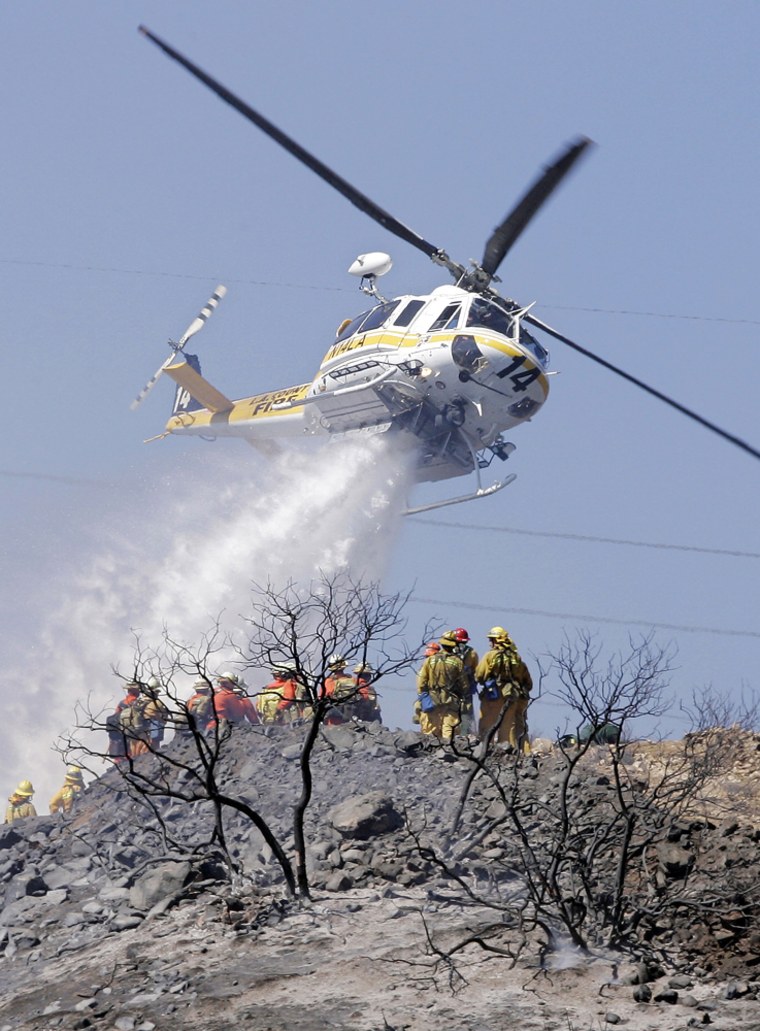The nation’s wildfire preparedness was raised to its highest level Thursday as dozens of new fires started in the bone-dry West, including a rapidly growing blaze on the grounds of the Idaho National Laboratory.
The West had been at level four for only a few weeks when officials decided to raise it to level five, effective Thursday.
“It’s driven by a couple of things: The number of large fires we have, and also the fires are occurring in several states and in several geographic areas,” said Randy Eardley, a spokesman for the National Interagency Fire Center. “The resources we have are being stretched thin.”
The change allows fire managers to request help from international crews, and National Guard units could be mobilized. On Thursday, fire center spokesman Ken Frederick said new crews were arriving in the Pacific Northwest from Alaska and the Southeast.
Choppers needed
Firefighters in the area critically need medium-sized helicopters, he said. With 23 uncontained large fires or fire complexes in Nevada, Utah and Idaho, there aren’t enough contractor-supplied helicopters to go around, he said.
About 15,000 U.S. firefighters were already battling nearly 70 fires bigger than 100 acres in 12 states.
The level was raised as dry lightning blasted and sparked dozens of new blazes in the West, including more than 1,000 new fires since Monday, Eardley said.
Thursday morning brought slightly lower temperatures in the Northwest, Frederick said, but the break wasn’t expected to last long. Dry, windy weather, temperatures over 100 and thunderstorms were forecast for the next seven days, he said.
A new wildfire that started Wednesday evening on the Idaho National Laboratory grounds quickly swept across nearly 15 square miles or 9,500 acres of sagebrush and grassland at the 890-square-mile nuclear research area in the southeast Idaho desert. Its cause was not known, said John Epperson, an INL spokesman.
No INL facilities were in immediate danger, but the lab’s 700 employees in the building nearest the fire were told to stay home Thursday. Other facilities at the lab, which employs about 3,600 workers, remained open.
Fire crews set a backburn to keep the fire from jumping the highway and “that appears to be working,” INL spokesman Ethan Huffman said late Wednesday night. The blaze was about 10 percent contained.
The nearest INL facility is the Materials and Fuels Complex, roughly five miles northeast of the edge of the fire and on the other side of the highway. Huffman described the complex as an area of research in nuclear reactor fuel development.
He said the metal-roofed complex was surrounded by vast sand buffers and the wildfire posed no danger to it, but operations were suspended Thursday and the workers told to stay home.
Part of Zion closed
Also Thursday, in southwestern Utah, the backcountry of Zion National Park was closed for hiking, climbing and rappelling because of the threat of wildfires. The main trails in the park’s Zion Canyon were still open.
Southeast of Boise, a fire was burning on nearly 4 square miles of grass and brush-covered Bureau of Land Management property. Though still relatively small, the lightning-sparked fire was racing toward Danskin Mountain where fire managers feared it would threaten lookout towers and other buildings, bureau spokeswoman Jessica Gardetto said.
In Nevada, one wildfire threatened hundreds of homes on the edge of Reno but weather and wind conditions there were improving Thursday. It was about 15 percent contained.
The small town of Jarbidge, nestled in a tight canyon near the Idaho line, was evacuated because authorities feared its 40 residents wouldn’t be able to escape if a forest fire nearby cut off access.
“Our decision last night was to move them out while we could,” Elko County Sheriff Dale Lotspeich said Thursday. “The bottom line is, if the fire goes into the canyon, the likelihood that it can be stopped is slim to none.”
The largest wildfire in Oregon, near Burns in the southeast portion of the state, had grown to more than 200 square miles and was threatening a handful of homes, officials said.
In Utah, two new large fires were reported, in addition to three already burning on about 640 square miles of grass, sage and timber. It was so dry there that some Utah communities banned traditional July 24 fireworks that members of the Church of Jesus Christ of Latter-day Saints normally shoot off to celebrate the 1847 arrival of Mormon pioneers in the Salt Lake Valley.
In Southern California, authorities were trying to stop a 43-square-mile wildfire from spreading toward about 50 scattered homes in Los Padres National Forest in the interior of Santa Barbara County. In Northern California, overnight drizzle helped firefighters battling flames that threatened more than 300 homes in and around Happy Camp in the Klamath National Forest near the Oregon border.
Fires in eastern Washington eased Wednesday when thunderstorms brought welcome rain, allowing some firefighters to be redeployed. Skies were overcast Thursday, and many evacuation orders were canceled.
